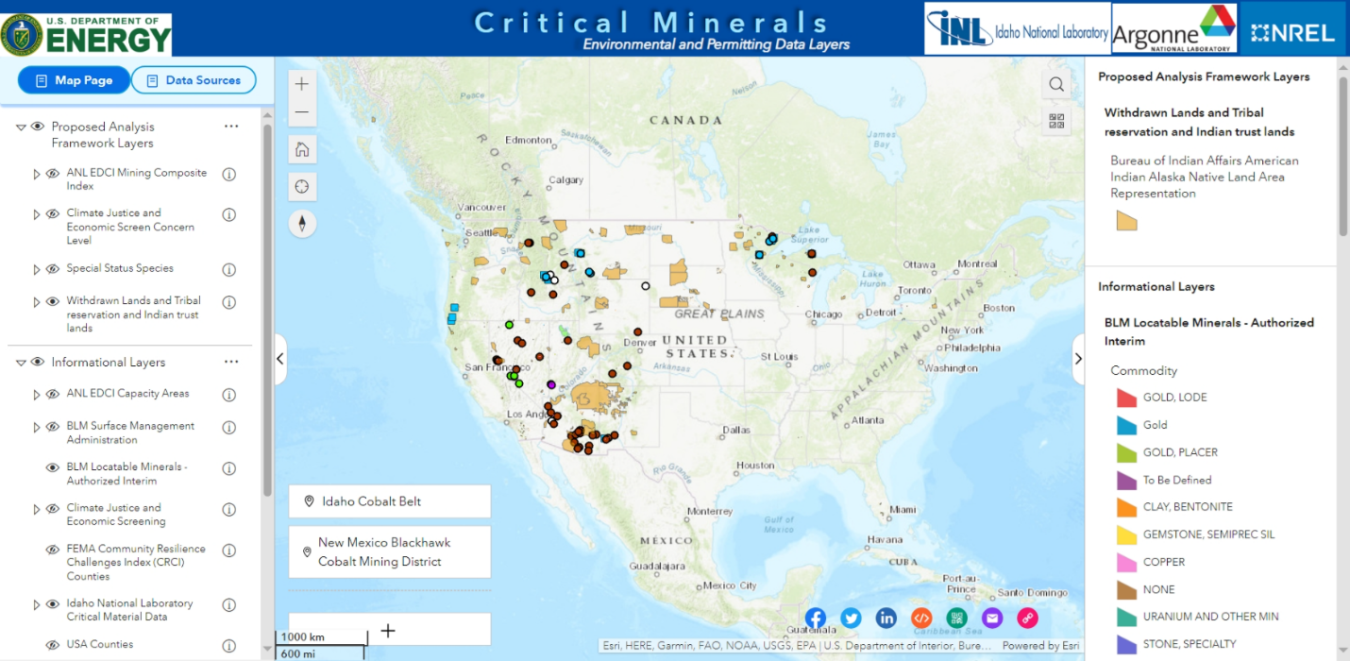New DOE platform improves data access for critical minerals development.
Office of Manufacturing and Energy Supply Chains
January 13, 2025The U.S. Department of Energy’s (DOE) Office of Manufacturing and Energy Supply Chains (MESC) Modelling, Mapping, and Analysis Consortium (MMAC) (comprised of MESC, National Renewable Energy Laboratory (NREL), Argonne National Laboratory (ANL), and Idaho National Laboratory (INL)) today released a new report and a GIS platform for critical minerals and materials (CMM) data. This project was a joint effort between NREL, INL and ANL, and funded by the MESC and DOE’s Office of Policy.
Domestic access to CMMs is essential for national security and supply chain resilience. Through Bipartisan Infrastructure Law (BIL) and Inflation Reduction Act (IRA) funding, MESC is supporting a portfolio of strategic investments in critical material projects that enhance economic and national security by eliminating vulnerabilities in the United States' energy supply chains.
However, the extracting and refining of CMMs can often come into tension with social and environmental considerations, such as wildlife and ecosystem conservation and preservation of access to public lands. Valuable data that can inform CMM development is often dispersed across various agencies and exists in diverse formats, making it challenging to efficiently site and permit projects. The 2023 Mining Reform Interagency Working Group Report included improved data digitization and transparency as one of its recommendations, recognizing that informational improvements and “integrating geologic, environmental, and cultural data into a common platform may increase the capacity to avoid adverse impacts, minimize impacts that cannot be avoided, and further mitigate impacts that remain.”
In light of these data challenges, MESC funded a GIS platform that integrates over 125 layers of geographic, environmental, and socioeconomic data into a user-friendly, open-source platform. This tool provides a comprehensive visualization of relevant data, including potential critical mineral deposits and environmentally sensitive areas, supporting informed decision-making in project siting and permitting. Throughout this project, the DOE and national lab project team consulted closely with U.S. Geological Survey (USGS), Bureau of Land Management (BLM), and U.S. Forest Service (USFS) staff.
This initial effort focused on relevant CMM deposits across 13 states. The accompanying report outlines the methodology for developing the data layers in the GIS platform, an analysis framework leveraging the data layers in the GIS platform, and a notional assessment of Cobalt sites in the 13-state region. In future work with DOE national labs, the CMM dataset will be expanded to the entire contiguous US and digitize further archival data relevant to CMMs. For inquiries related to this project, contact MESCanalysis@hq.doe.gov.
Learn more about MESC’s mission to catalyze investments in America’s energy future and support of the re-shoring, skilling, and scaling of U.S. manufacturing across energy supply chains.
Topics: Critical Minerals and Materials


